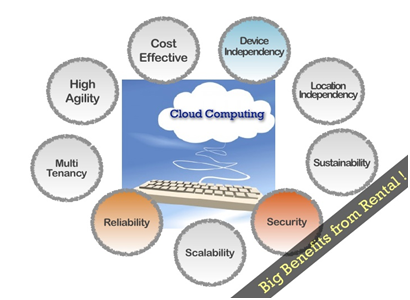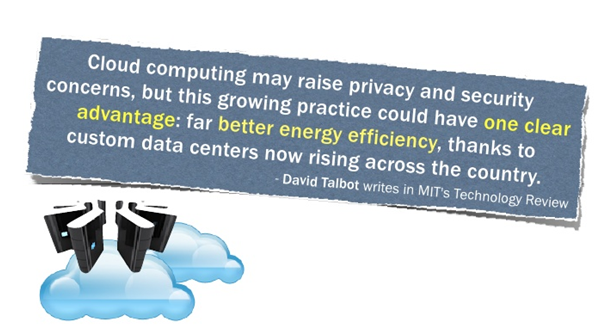A CLOUD WITH A GREEN LINING
Before merging the two hot topics of today- cloud computing and green IT. It would be safe to fine define a cloud in laymen terms.
A cloud can be called as “collection of software and hardware” which is available on the internet. These resources are then managed by third party services.
What is cloud computing?
In very easy to understand language it can be defined as: “where computing is done at remote location rather than any portable devices or personal computers.” There are several benefits of “cloud computing” and as a picture speaks more than words, it can be expressed by this picture:

Now the big question arises…
Do we turn ‘green’ automatically by moving to the cloud?
Well, the answer is YES!

One of the principles of cloud computing is the flexibility of using the services as per need and paying according to use (pay per use). In addition, these services run on shared infrastructure. So we are using the energy just as much as we need, and utilizing existing resources without investing on new additional infrastructure.
No extra computers, resources are needed. Additional computers would have meant extra idling time as well. So all this is avoided with the concept of utility computing.
It can be viewed as PUBLIC TRANSPORT VS PRIVATE TRANSPORT.
Cloud computing being a public transport in itself is energy efficient, money efficient as well resource efficient.
Every search, every activity we perform on the computer leaves a carbon footprint. Our IT being so complex and large consumes high level of energy. So moving to the cloud is a great way to check energy consumption.
A green lining to cloud:
- Cloud computing providers strive to maximize the performance of their operations and can achieve higher utilization rates than in-house data centres.
- Cloud data centres can be developed at strategic locations, or integrated with renewable sources of energy.
Examples:
- Hewlett-Packard developed a wind-cooled data centre in England. Google’s data centre in Saint-Ghislain, Belgium, functions without chillers.
- TCS – Going Paperless with online forms, business processes and workflows yielded a significant reduction in paper consumption for its operations. Measures to enforce double-sided printing, shared printing reduction in paper consumption and a 68% to the prior year.
- Infosys, through a large Green IT Program covering server and storage server rollouts, and virtualization, gained the following financial benefits:
Ø Direct cost savings of US$ 130,000
Ø Annual savings of US$ 70,000 on data centre maintenance costs
Ø Reduced server count by 98%, achieving significant cost reduction
But the uncertainties continue:
According to a survey by Rackspace Hosting1, only 20% believe that hosted solutions play a role in making their firm greener. An additional 34% of those customers are currently trying to evaluate the efficiencies and ‘greenness’ of Cloud. As more and more enterprises opt for Cloud, data centres end up using more electricity to run computers, as well as meet back-up and cooling demands. Experts believe that Cloud companies may choose output over environmental considerations in the future.
Conclusion
A cloud is an energy saving option no doubt. By implementing of it it is expected to-
- Enhance brand image of the companies with respect to environmentally sensitive clients, and also for the general public
- Enhance stakeholder value
- Enhance employee morale and retention
- Help ensure regulatory compliance
- Improve corporate governance and sustainability
In the last years, technology has improved immensely, taking the environment into account and providing a solution for those worrying about carbon footprints and the impact of technology into the environment. And with the booming development of cloud computing technologies, it will add to green IT in more proficient ways.
Rashi Sinha
Latest posts by Rashi Sinha (see all)
- A CLOUD WITH A GREEN LINING - August 25, 2012



